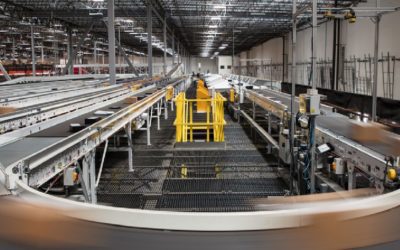How to Work With a 3PL (Third Party Logistics) Company
The business model of handling most operations in-house has prevailed in the past. However, organizations have found this isn’t necessarily the most productive, especially for smaller eCommerce businesses. Many eCommerce companies have found a way to expand operations while staying within budget by partnering with a third-party logistics provider.
Outsourcing to a third-party logistics service allows you to work with a professional on specific parts of your eCommerce business. At the same time, you focus on other aspects, such as product development, growth, and customer satisfaction.
Third-party logistics companies can provide supply chain management and transportation services as part of the order fulfillment process. The 3PL company is an essential link between your manufacturing operations and your customers, and when order fulfillment runs smoothly, you have satisfied end customers and a growing business.
Before you begin working with a 3PL provider, you should understand what 3PL is and how to incorporate it into your operations with the best 3PL partner.
What is a 3PL?
3PL (third-party logistics) refers to outsourced logistics services encompassing the management of one or more facets of procurement and the fulfillment process. In business, 3PL has a comprehensive meaning for storing or shipping items. A 3PL service could be one provider, such as trucking services or warehouse management, or it might be a system of services able to handle supply chain management.
How Does 3PL Work?
Although the 3PL fulfillment services will vary, the typical process looks like this:
- The 3PL provider receives your inventory at its warehouse and organizes each SKU.
- When a customer places an order on your eCommerce site, it’s forwarded to the 3PL provider via API or EDI.
- A worker at the 3PL warehouse gets a picking list to retrieve the items.
- The worker packs the items in boxes the same day with a receipt and order details.
- The 3PL prints the shipping label or uses one of its shipper’s labels.
- The trucking company picks up the package from your 3PL’s distribution center and delivers it to your end customer.
- Tracking information is uploaded to the 3PL system and synchronized with your order management software.
Here is one example of how 3PL arrangements can enhance the customer experience: A manufacturer hires designers, skilled labor, and operators to produce fasteners, but it does not want to handle the transportation of its product. Instead, the company uses a distribution center or fulfillment center to process its online orders and hires a trucking carrier to haul its fasteners. The fulfillment center and trucking company both act as 3PL providers. It’s also possible for a single 3PL provider to fulfill and ship the fasteners.
By using a 3PL provider, the manufacturer can use the 3PL service providers only when needed, which is more cost-effective and allows the company to focus on its core competency of producing fasteners.
What are the Benefits of Working with a 3PL?
Together with a company’s growth are numerous demands on the supply chain. They become caught in the middle of focusing on their current business needs and improving their service levels. Here is where a third-party logistics provider can help.
A 3PL service takes over warehousing, order fulfillment, trucking, and reverse logistics (a fancy name for handling returns). The cost savings of not having to maintain their own warehouse, manage workflows, and maintain a staff to monitor supply chain operations are impressive.
A 3PL service offers better performance on transportation services while also finding it easier to scale its operations. For instance, if the manufacturing company in the example above receives an order for several pallets of fasteners, the fulfillment center can more easily meet the sudden demand than if the manufacturer had to ship all those pallets themselves.
If the company chooses a third-party logistics provider with experience, it should realize the following benefits:
Wider Market Reach
A third-party logistics provider helps you cover areas your product has not yet reached. A nationwide network of warehouses supported by technology to streamline fulfillment across more sales channels enables companies to best serve eCommerce customers in critical regions because of first-rate inventory management. Companies also monitor sales and distribution in real time without managing it themselves.
Increased Flexibility
3PL providers can match the company’s needs by boosting transportation recruitment, increasing warehouse space, and accommodating seasonal inventory levels. 3PL providers free you from maintaining an in-house supply chain management system, allowing you the extra time and resources to use without affecting their bottom line by acquiring equipment.
A Wide 3PL Provider Network
As the 3PL provider distributes your company’s product to a broader area, they use other warehouses and distribution centers. Experienced 3PL providers are already working with a network of distributors, which is extremely difficult to do in an in-house setting—allowing the logistics provider to tap their connections results in lower overhead, cost-effective service, and profitability.
Lower Capital Commitment
Partnering with a 3PL provider spares a company from purchasing the technologies to running an in-house logistics operation, hiring extra people, paying overhead expenses, and maintaining the warehouse. Paying for third-party logistics services is ideal for companies without experience and skills in the supply chain. With all the risks minimized, partnering with 3PL can potentially increase sales.
Optimized resources
Third-party logistics providers save you from warehouse management headaches, hiring costs, transportation costs, and more. Since this part of supply chain management occurs outside the company, you decrease the cost of product distribution and have more time to focus on the business. Typically, the 3PL provider will provide a cost projection forecasting how much your company can save with its services. Hiring a logistics provider avoids the need for in-house training, billing, and auditing.
Be Aware of a Few 3PL Misconceptions
Myths and misconceptions are part of the business world, and 3PLs have their share. Here are three of the most common.
“You lose control when you turn things over to a 3PL.”
Although inventory stored in a 3PL warehouse isn’t immediately accessible, working with a 3PL allows you to regain control. After you are relieved of the responsibility of shipping, the fulfillment process (including kitting), and inventory management, you will discover that errors are less likely. A top-notch 3PL will also provide reports and analytics, allowing you to manage the process remotely and assist you in making more intelligent business decisions.
“3PLs are exclusively for the big guys like FedEx and Amazon.”
Not so! A 3PL is suitable for any business hoping to grow. Don’t make the mistake of assuming the cost of third-party warehousing and distribution centers is beyond your price range, and you will likely reduce your overhead costs and free up capital.
Pricing for 3PLs can be complex, and additional fees may include inbound costs, storage costs, outbound costs, customs and duties, and even custom packaging. However, these are not hidden fees; they are plainly laid out for you before you sign a contract.
Are a 3PL and Freight Forwarder the Same Thing?
Logistical terms are often confusing, and some that appear to be interchangeable are not after you learn more about them. Case in point, 3PL logistical services, and freight forwarding are two terms that are similar but quite different after a closer look.
A freight forwarder is a specialist focused on moving goods between points A and B. Freight forwarders are the service providers arranging the entire process. If your products move across different transportation modes, such as from ships to trucks or trains, the freight forwarder manages this for your company.
On the other hand, the 3PL is a specialist managing your logistics needs, including moving those same products. Third-party logistics providers typically offer many more services than a freight forwarder, and they support your products with warehousing, order fulfillment, and trucking services. And if the customer returns the product, they handle the reverse logistics.
A 3PL is more interconnected with your business, significantly impacting customer service and satisfaction. The right 3PL provider helps you prepare the warehouse and products before an order is placed, helps you lower shipping costs, and fills orders when someone buys from your company.
How Does a 3PL Differ From a 4PL?
The primary difference between third-party and fourth-party logistics is that a 4PL handles the entire supply chain, and a 3PL focuses on logistics. Since each provides advantages, you should understand what you get from each type of provider to make the best decision for your company.
Look to Titan Worldwide for Industry-Leading 3rd Party Logistic
We have established our reputation for regularly creating solutions for some of the most significant trucking and logistics issues. We make sense of your problems and optimize the processes from the past data, accelerating your trucking and logistical planning by delivering solutions that make your vision a reality.
Check out our Logistics Services page for more information and solutions for your business, or contact us today for a free quote.




